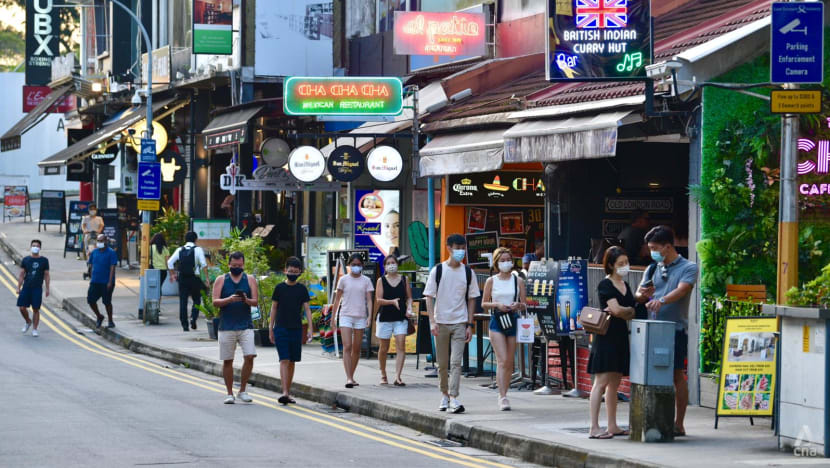- Joined
- Sep 28, 2011
- Messages
- 4,133
- Points
- 113
Interesting article...

Caption for photo
Every year, new mutations of a higly transmissible infectious disease come through Singapore and kill some 800 persons annually — that’s the higher range of estimates by public health experts. The disease is easily spread through close contact and droplets. It is so endemic, it is hard to even estimate how many get it but with such mild symptoms (for the great majority) many do not even bother to see a doctor.
We’re talking about influenza, or the “flu”.
A scientific paper from 2006, “Influenza-associated Deaths in Tropical Singapore” by Angela Chow, Stefan Ma, Ai Ee Ling and Suok Kai Chew (but based on a study that spanned eight years) found that influenza-associated mortality in Singapore occured at a rate of about 14.8 deaths per 100,000 population. This was similar to the rate in Hong Kong, which was found to be 16.4 per 100,000.
Multiplied by our current population, this suggests an annual total of about 844 deaths a year in Singapore.
Influenza kills more elderly people than younger persons. Among patients over 65 years old, the mortality rate was 167.8 persons per 100,000.
The Singapore Ministry of Health’s HealthHub site has a webpage (accessed 31 August 2021) that, however, gives a lower annual figure. It says “An earlier study had estimated that influenza caused 588 deaths in Singapore annually”. It’s not clear which earlier study this refers to.
The same HealthHub page also says that “In Singapore, influenza-associated hospitalisation has been estimated to be 29.6 per 100,000 persons each year, or about 1,500 hospitalisations per year.” That works out to be about 125 hospitalisations a month.
A total of 588 – 844 influenza-associated fatalities a year (depending on which source one prefers to use) suggests that those patients who had to be hospitalised were generally very ill indeed. About half the 1,500 hospitalisations a year don’t make it out of the hospital alive.
See also “Influenza-Associated Hospitalizations, Singapore, 2004–2008 and 2010–2012″ by Ang Li Wei and others, and a feature in TODAY newspaper dated 16 August 2017: “When flu turns fatal“. There is also a feature in the Straits Times from 19 April 2020 recounting the flu crises that have hit SIngapore in decades past: “Three times that the world coughed, and Singapore caught the bug“.

As at 27 August 2021, Singapore has recorded 55 deaths from Covid-19 (source). This total covers a period of 17 months since the first fatality in late March 2020.
As at 30 August 2021, “441 cases [were] currently warded in hospital,” reported the Ministry of Health in its daily press release. Most were well and merely under observation, the ministry said. “There are currently 19 cases of serious illness requiring oxygen supplementation, and 5 in critical condition in the intensive care unit (ICU).”
The 19 serious cases of Covid-19 currently in hospital is a far cry from the approximately 125 influenza hospitalisations a month (1,500 flu hospitalisations a year divided by 12), which also seem to be very serious indeed as explained above.
The 55 Covid-19 deaths so far almost pale in comparison with the roughly 800 flu-associated deaths a year.
And yet, the Ministry of Manpower uses Covid-19 as justification for the continued internment of migrant workers in their dormitories, sixteen months after the lockdown began.
How rational is this?

“… with more than nine in 10 dorm residents now fully vaccinated against Covid-19, infectious disease experts say it is hard to justify the restrictions, especially given the impact on mental health,” reported the Straits Times on 29 August 2021 (link).
Associate Professor Alex Cook, vice-dean of research at the National University of Singapore’s (NUS) Saw Swee Hock School of Public Health, said the public health justification for the continued restrictions is to stop infections from the community entering dorms, and prevent dorm infections from getting back out.
But unlike last year, there are now more infections being detected in the community than in the dorms.
“Given that the public health benefits are marginal at best… we should seriously consider relaxing these restrictions as we relax measures in the community,” he said.
— 29 August 2021, Straits Times, Plan to let migrant workers into community still on hold after new Covid-19 clusters in dorms over past month (link).
Another public health expert, Jeremy Lim, set out the arguments even more cogently to the website Mothership. In his mind, it came down to the point where “I don’t think it’s the sensible or the prudent public health thing to do anymore,” Mothership quoted him as saying in the article “S’pore public health expert explains why migrant workers should be allowed back into the community”, 28 August 2021. This article is certainly worth a read.
Jeremy Lim is the director of global health at the Saw Swee Hock School of Public Health at the National University of Singapore, the chairman of the Medical Services Committee of HealthServe, a local NGO that offers medical and social assistance to migrant workers.
Indeed, if despite its worse numbers than Covid-19, we could live normally with influenza in years past, why are we still locking up migrant workers?
800 deaths a year — and life carries on normally
August 31st, 2021|Articles, Stories
Caption for photo
Every year, new mutations of a higly transmissible infectious disease come through Singapore and kill some 800 persons annually — that’s the higher range of estimates by public health experts. The disease is easily spread through close contact and droplets. It is so endemic, it is hard to even estimate how many get it but with such mild symptoms (for the great majority) many do not even bother to see a doctor.
We’re talking about influenza, or the “flu”.
A scientific paper from 2006, “Influenza-associated Deaths in Tropical Singapore” by Angela Chow, Stefan Ma, Ai Ee Ling and Suok Kai Chew (but based on a study that spanned eight years) found that influenza-associated mortality in Singapore occured at a rate of about 14.8 deaths per 100,000 population. This was similar to the rate in Hong Kong, which was found to be 16.4 per 100,000.
Multiplied by our current population, this suggests an annual total of about 844 deaths a year in Singapore.
Influenza kills more elderly people than younger persons. Among patients over 65 years old, the mortality rate was 167.8 persons per 100,000.
The Singapore Ministry of Health’s HealthHub site has a webpage (accessed 31 August 2021) that, however, gives a lower annual figure. It says “An earlier study had estimated that influenza caused 588 deaths in Singapore annually”. It’s not clear which earlier study this refers to.
The same HealthHub page also says that “In Singapore, influenza-associated hospitalisation has been estimated to be 29.6 per 100,000 persons each year, or about 1,500 hospitalisations per year.” That works out to be about 125 hospitalisations a month.
A total of 588 – 844 influenza-associated fatalities a year (depending on which source one prefers to use) suggests that those patients who had to be hospitalised were generally very ill indeed. About half the 1,500 hospitalisations a year don’t make it out of the hospital alive.
See also “Influenza-Associated Hospitalizations, Singapore, 2004–2008 and 2010–2012″ by Ang Li Wei and others, and a feature in TODAY newspaper dated 16 August 2017: “When flu turns fatal“. There is also a feature in the Straits Times from 19 April 2020 recounting the flu crises that have hit SIngapore in decades past: “Three times that the world coughed, and Singapore caught the bug“.

As at 27 August 2021, Singapore has recorded 55 deaths from Covid-19 (source). This total covers a period of 17 months since the first fatality in late March 2020.
As at 30 August 2021, “441 cases [were] currently warded in hospital,” reported the Ministry of Health in its daily press release. Most were well and merely under observation, the ministry said. “There are currently 19 cases of serious illness requiring oxygen supplementation, and 5 in critical condition in the intensive care unit (ICU).”
The 19 serious cases of Covid-19 currently in hospital is a far cry from the approximately 125 influenza hospitalisations a month (1,500 flu hospitalisations a year divided by 12), which also seem to be very serious indeed as explained above.
The 55 Covid-19 deaths so far almost pale in comparison with the roughly 800 flu-associated deaths a year.
And yet, the Ministry of Manpower uses Covid-19 as justification for the continued internment of migrant workers in their dormitories, sixteen months after the lockdown began.
How rational is this?

“… with more than nine in 10 dorm residents now fully vaccinated against Covid-19, infectious disease experts say it is hard to justify the restrictions, especially given the impact on mental health,” reported the Straits Times on 29 August 2021 (link).
Associate Professor Alex Cook, vice-dean of research at the National University of Singapore’s (NUS) Saw Swee Hock School of Public Health, said the public health justification for the continued restrictions is to stop infections from the community entering dorms, and prevent dorm infections from getting back out.
But unlike last year, there are now more infections being detected in the community than in the dorms.
“Given that the public health benefits are marginal at best… we should seriously consider relaxing these restrictions as we relax measures in the community,” he said.
— 29 August 2021, Straits Times, Plan to let migrant workers into community still on hold after new Covid-19 clusters in dorms over past month (link).
Another public health expert, Jeremy Lim, set out the arguments even more cogently to the website Mothership. In his mind, it came down to the point where “I don’t think it’s the sensible or the prudent public health thing to do anymore,” Mothership quoted him as saying in the article “S’pore public health expert explains why migrant workers should be allowed back into the community”, 28 August 2021. This article is certainly worth a read.
Jeremy Lim is the director of global health at the Saw Swee Hock School of Public Health at the National University of Singapore, the chairman of the Medical Services Committee of HealthServe, a local NGO that offers medical and social assistance to migrant workers.
Indeed, if despite its worse numbers than Covid-19, we could live normally with influenza in years past, why are we still locking up migrant workers?

/fig1_23sep.png?sfvrsn=bffbdf03_0)
/fig2_23sep.png?sfvrsn=f90790d9_0)
/fig3_23sep.png?sfvrsn=d5497b37_0)









